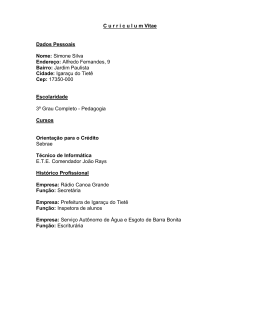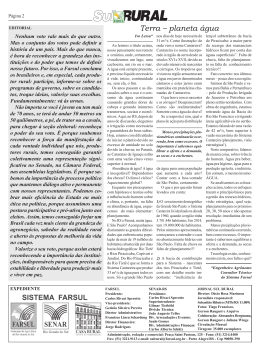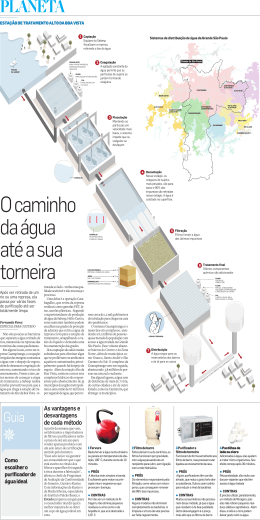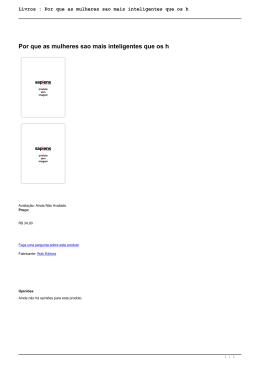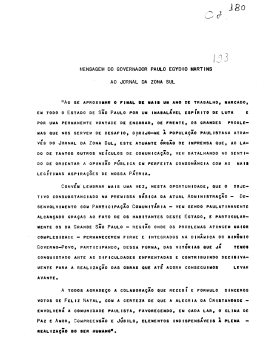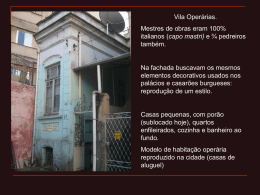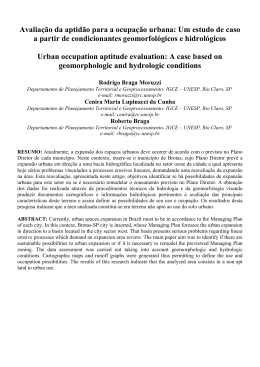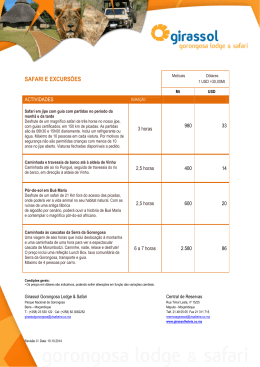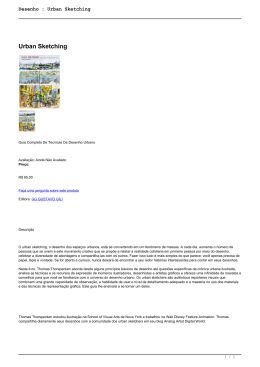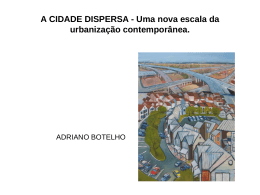Safari 4 é uma visita auto-guiada da fauna urbana ao longo da linha . Safari 4 is a self-guided tour of urban wildlife along the line. AUTO-GUIADAS: SELF-GUIDED TOURS: Tucuruvi Forest Edge Tucuruvi Forest Edge Along the line, subway riders can tour some of Sao Paulo’s liveliest ecosystems. The line travels from the city’s northern edge near the Cantareira Forest to its southern border at the Guarapiranga Reservoir. Between these two extents, the subway passes through dense residential neighborhoods, international airports teeming with life, municipal markets at the heart of the city, and the Tietê River, the site of Sao Paulo’s early settlement. Safari circulates an ongoing series of video tours and maps that explore the complexity, biodiversity, conflicts and potentials of Beijing’s ecosystems. Tours are available online for self-guided exploration of the city. Safari 1 is organized by São Paulo Lab (Studio-X Global Network), the Urban Landscape Lab and the Columbia University Graduate School of Architecture, Planning and Preservation Guest speakers and critics: Jörg Spangenberg (Urban Forests), Ligia Nobre (co-curator 10th Sao Paulo Architecture Biennial) and Joan Villa (professor at Mackenzie and Belas Artes Universities) Research Assistance: Sandro de Mauro, Lily Saporta-Tagiuri, Gina Wirth. Participants: Fernanda Lie Sakano, Lara Ferreira, Raquel Ruiz García, Juliana Freitas Lima, Bruna Cesar, Anne Schraiber, Gabriel Biselli, Marcella Arruda, Marcus Bastos, Camila Romano, Rita Mendonça, Silvia Chile, Sandro De Mauro, Mayara De Sá, Diogo Gambonni, Leire Calvillo Mendoza Tietê Flight Path A Self-Guided Tour of Urban Wildlife Along the 1 Line Ao longo dos passageiros do metrô da linha pode visitar alguns dos ecossistemas mais animadas de São Paulo. A linha viaja do extremo norte da cidade, perto da Floresta Cantareira para sua fronteira sul na Represa de Guarapiranga. Entre estas duas extensões, o metrô passa por bairros residenciais densas, aeroportos internacionais cheias de vida, mercados municipais, no coração da cidade, eo rio Tietê, o local da liquidação antecipada, em São Paulo. Safari circula uma série contínua de passeios de vídeo e mapas que exploram a complexidade, a biodiversidade, conflitos e potencialidades dos ecossistemas de Pequim. Tours estão disponíveis on-line para a exploração auto-guiada da cidade. A VISITA AUTO-GUIADA DA VIDA SELVAGEM URBANAS AO LONGO DA LINHA 1 SAFARI1.ORG Se o metrô se estendia mais ao norte, você poderia visitar pumas e macacos bugios na Floresta Cantareira. Mas você não precisa deixar a cidade para tocar na floresta. Acima de quase todos os prédios em São Paulo é um jarro azul enchido com água da Serra da Cantareira. Os campos abertos e florestas do Campo de Marte têm inadertently criado nidificação prolíficos para grande kiskadee e aves lawping sul. Tweet-titwee! Helicópteros cuidado! Tietê Selvagem Wasteland Olhe atentamente para as margens do Rio Tietê, e você pode ver capivara. Estes grandes, roedores gregários suportar lama espessa no rio para desfrutar de uma vida livre dos leopardos, allligators e cobras iriam encontrar no Pantanal. São Bento O lixo de um homem Por trás das pirâmides perfeitamente empilhadas de frutas no mercado municipal fica uma montanha de sucata de alimentos. Junte-se a nós para uma história de respigadores, resíduos e frutas exóticas voou para a cidade do outro lado do amazon. Entrevistas com os comerciantes Mercado Municipal e moradores locais .. Luz Leisure Time Da próxima vez que você está se sentindo apressado ou forçado, fazer uma pausa no Parque da Luz e olhar para as preguiças. Estes nativos da Mata Atlantica mover tão lentamente que eles são um anfitrião perfeito para um micro ecossistema de insetos, fungos e algas .. If the subway stretched further to the north, you could visit pumas and howler monkeys in the Cantareira Forest. But you don’t need to leave the city to touch the forest. Above almost every building in Sao Paulo is a blue jug filled with water from the Serra de Cantareira. Tietê Flight Path The open fields and forests of Campo de Marte have inadertently created prolific nesting grounds for great kiskadee and southern lawping birds. Tweet-ti-twee! Helicopters beware! Tietê/Armênia Wasteland Wilderness Look closely at the banks of the Tietê River, and you can see capybara. These large, gregarious rodents endure thick sludge in the river to enjoy a life free from the leopards, allligators and snakes they would encounter in the Pantanal. São Bento One Man’s Trash Behind the perfectly stacked pyramids of fruit at the municipal market sits a mountain of food scrap. Join us for a story of gleaners, waste and exotic fruit flown into the city from beyond the amazon. Interviews with Mercado Municipal merchants and local residents.. Luz Leisure Time Next time you’re feeling rushed or stressed, take a break at Parque da Luz and look for sloths. These natives of the Mata Atlantica move so slowly that they are a perfect host for a micro ecosystem of insects, fungi, and algae.. Vergueiro Concrete Jungle Vergueiro Concrete Jungle Acima do Centro Cultural São Paulo, as pessoas aproveitar a luz do sol em uma vibrante jardim no terraço. Na sombra abaixo, liquens, musgos e algas que vivem nas paredes de concreto trabalhar para absorver poluentes e de CO2 no ar. Above the Centro Cultural São Paulo, people bask in the sunlight on a vibrant roof garden. In the shade below, lichen, moss and algae living in the concrete walls work to absorb CO2 and airborne pollutants. Ana Rosa Rivers ocultos Ana Rosa Hidden Rivers Sob as ruas de São Paulo, milhares de rios ocultos são confundidos com sistema de esgoto da cidade. Siga o Rio Caaguaçu em Parque Ibirapuera com José Bueno dos sem fins lucrativos Rios de e Ruas. Beneath Sao Paulo’s streets, thousands of hidden rivers are mistaken for the city’s sewer system. Follow the Caaguaçu River into Parque Ibirapuera with Jose Bueno from the nonprofit Rios e Ruas. Vila Mariana Mata Atlantica Nursery Villa Mariana Mata Atlantica Nursery De São Paulo plantas luta contra a invasão de espécies exóticas, como o eucalipto. Manequinho Lopes berçário para o resgate! Aqui, árvores fom da Mata Atlântica são cultivadas e enviados para parques ao redor da cidade. Sao Paulo’s plants struggle against the invasion of exotic plant species like the eucalyptus tree. Manequinho Lopes nursery to the rescue! Here, trees fom the Mata Atlantica are cultivated and sent to parks around the city. Praça da Árvore Arquipélago Urbano Praça da Árvore Urban Archipelago Os ladrões não são os únicos afetados por portões de segurança e arame farpado. Veja como linhas de propriedade criaram pequenos habitats da ilha em toda a cidade. Entrevistas com moradores locais. Thieves aren’t the only ones affected by security gates and barbed wire. See how property lines have created tiny island habitats throughout the city. Interviews with local residents. Jabaquara Reservatórios Jabaquara Reservoirs Enquanto São Paulo cresce, as áreas ao redor do Reservatório Guarapiranga anteriormente protegidos de desenvolvimento industrial e comercial tornaram-se o lar de muitas favelas. A história da interdependência entre a água, esgoto, habitação e infraestruturas. As Sao Paulo grows, areas around the Guarapiranga Reservoir previously protected from industrial and commercial development have become home to many favelas. A story of the interdependence between water, sewer, and housing infrastructures. COMO USAR SAFARI 1 How to use Safari 1 Visite Safari1.org. Assista ao vídeo passeios auto-guiados on-line ou baixá-los para seu telefone inteligente ou mp3 player. Visit Safari1.org. Watch the self-guided audio tours online, or download them onto your smart phone or mp3 player. Assista os podcasts durante seu passeio na linha 1, ou enquanto caminha pela cidade. Watch the podcasts during your ride on the 1 line, or while walking through the city. Confira a fauna urbana ao longo do caminho. Check out the urban wildlife along the way.
Download
